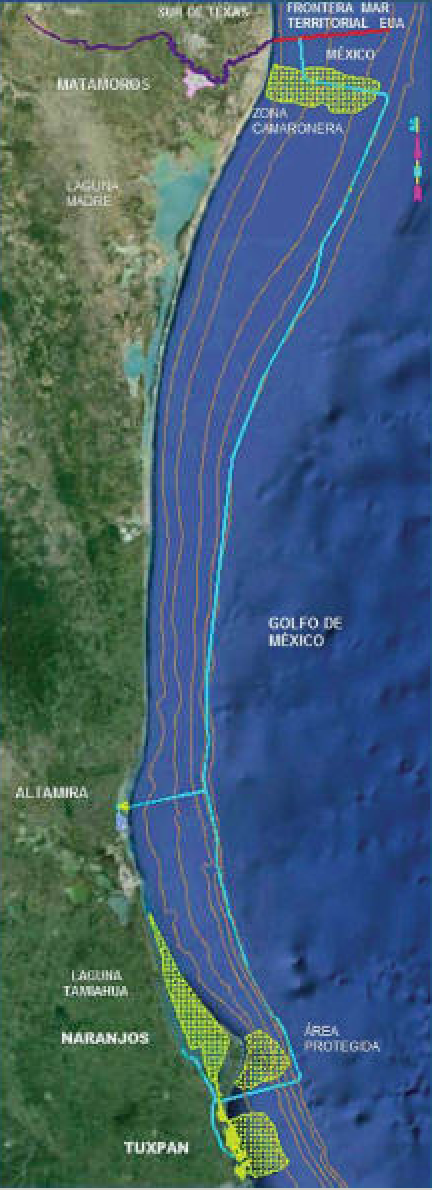October 2017, Vol. 244, No. 10
Features
Sur de Texas-Tuxpan Pipeline Key to Mexico’s Power Supply

According to recent estimates for 2025, Mexico’s demand for natural gas will double Pemex’s production in 2012. Current domestic market conditions suggest the production growth rate will have to increase by 2.9% per year to meet that demand.
This is why the Federal Electricity Commission (CFE) has approved construction of 24 natural gas pipelines at an investment of $6.78 billion in order to add capacity 8.4 Bcf/d and a total length of 2,385 km, until 2023.
A 42-inch pipeline in the Gulf of Mexico will be approximately 800 km in length. It will include a branch in Altamira Tamaulipas capable of transporting natural gas from South Texas – near the border with Matamoros – to the city of Tuxpan in the state of Veracruz. The work will help meet growing natural gas requirements at CFE power plants in the states of Tamaulipas and Veracruz, as well as in the east, central and west regions of Mexico. The $3.1 billion pipeline is expected to start operating in December 2018 or early 2019.
The project is supported by a 25-year natural gas transportation service contract for 2.6 Bcf/d with Mexico’s state-owned power company. TransCanada Pipelines will develop, operate and own 60% of this project, with IEnova owning 40%. TransCanada expects to invest approximately US$1.3 billion in the partnership to construct the gas pipeline that will begin offshore in the Gulf of Mexico.
In addition to a connection with CENAGAS’s pipeline system in Altamira, the project will interconnect with TransCanada’s Tamazunchale and Tuxpan–Tula pipelines as well as with other transporters in the region.
The Sur de Texas–Tuxpan Pipeline is the most recent addition to TransCanada’s expanding portfolio in Mexico. In the past eight months, TransCanada was awarded the Tuxpan–Tula and the Tula–Villa de Reyes pipelines. Construction on these two pipelines is in progress with the expectation of achieving in-service dates next year.
In the city of Altamira, where construction of the first section of the pipeline began, the logistics and production center for the production of about 53,000 pieces of concrete-coated steel pipe was also installed. This procedure, following Pemex specifications, consists of applying a corrosion-resistant compound to clean the impurity and rust by means of steel grit, using a special sandblast machine.
The company in charge of constructing the offshore gas pipeline is Allseas, using its three vessels, Solitaire, Tog Mor and Calamity Jane. The goal is to install 685 km to a depth between 100-300 meters the 42-inch pipeline dual 42-inch pipe pull-out at Altamira and direct 42-inch pipe push-out at Tuxpan, 4 x 42-inch pipe above water tie-ins, 545 km post-lay trenching, and finally pre-commissioning and testing of the system.
Tog Mor is a flat-bottom, anchored barge for shallow water construction. It is equipped with a 10-point mooring system, pipe-lay equipment suitable for laying pipe up to of 60 inches in diameter and a piggyback firing line for 6.5-inch pipe. The vessel is fitted with a davit system, enabling it to perform midpoint tie-ins and a 300-tont crane for construction work.
Tog Mor operates primarily in shallow water areas, both in support of Allseas’ pipelayers and for independent contractors. It can lay pipes up to a water depth of 150 metgers without modification; deeper water projects are possible with modification to the winches and stinger.
Prior to pipelay, a survey is conducted by a remotely operated vehicle (ROV) which is equipped with sensors, cameras and sonar equipment. The ROV transmits information to the survey vessel via an umbilical cable. Results then immediately identify possible pipeline hazards such as wrecks, obstacles and seabed unevenness.
ROVs also provide seabed touchdown point monitoring and subsea construction support. As soon as the pipeline has been laid, it will be subjected to an ROV inspection. This post-lay survey defines the accurate position of the pipeline, the pipe-seabed configuration and the external status of the pipe. The as-laid results help determine the need for post-lay intervention work, such as span correction or rock dumping.





Comments